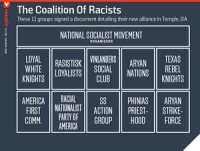-
The Devil’s puzzle: Defining international and domestic terrorism
It’s becoming a familiar scene. A vehicle becomes a weapon of terror. This time in New York City, where a driver in a rental truck suddenly careened down a bike and pedestrian path on the west side of the city on Tuesday, killing at least eight and injuring more than ten people. New York officials say it was an act of terror, and the incident is likely to reignite the debate on what constitutes domestic and international terrorism and whether it matters. An argument can be made that distinguishing between what constitutes an act of terrorism and what doesn’t still provide significant value.
-
-
Police were told of Adam Lanza’s plan to carry out school mass shooting -- 4 years before he did

In 2008, four years before Adam Lanza went on a shooting spree at Sandy Hook Elementary School in Newtown, Connecticut, the local police were told that he planned to carry out a massacre. The local police at the time, and legal experts since, say it is unclear what officials could have done to stop the attack at the point they were alerted to Lanza violent musings. All firearms in the Lanza home had been legally purchased by Nancy Lanza, whom Lanza shot and killed in her bed the morning of 14 December before going to the school and fatally shooting twenty children and six staff members. In response to a FOIA request, the FBI release a batch of heavily redacted documents – 1,500 pages in all – which also show Lanza’s interest in pedophilia, and his obsession with mass shooting.
-
-
Unprecedented levels of cross-border cooperation among extreme right groups: Report

New research released the other day by ISD, a counter-extremism NGO, reveals increasing collaboration among extreme far-right groups globally. The report shows how extreme right groups have been opportunistically, and effectively, bridging ideologies and adapting their tone to manipulate legitimate social grievances – immigration, freedom of speech, and terrorism – in order to reach and radicalize mainstream parties and movements.
-
-
Acoustic gunshot sensor technology may benefit shooting victims
A number of U.S. cities have installed acoustic gunshot sensor technology to accurately locate shooting scenes and potential gunshot victims, but the effectiveness of this technology for saving lives had not been studied until now. A new study shows that the technology contributes to quicker hospital arrival times and equal survival rates despite more severe injuries.
-
-
Are many hate crimes really examples of domestic terrorism?
This growing domestic menace deserves more attention than it’s getting. I consider domestic terrorism a more significant threat than the foreign-masterminded variety in part because it is more common in terms of the number of attacks on U.S. soil. The number of violent attacks on U.S. soil inspired by far-right ideology has spiked since the beginning of this century, rising from a yearly average of 70 attacks in the 1990s to a yearly average of more than 300 since 2001. Despite an uptick in far-right violence and the Trump administration’s plan to increase the Department of Homeland Security budget by 6.7 percent to $44.1 billion in 2018, the White House wants to cut spending for programs that fight non-Muslim domestic terrorism. The federal government has also frozen $10 million in grants aimed at countering domestic violent extremism. This approach is bound to weaken the authorities’ power to monitor far-right groups, undercutting public safety.
-
-
Normalizing white nationalist hate

A panel of experts met last week at Harvard University’s Kennedy School (HKS) to examine the U.S. white nationalist movement’s rise to prominence and discuss ways to counter it. One panelist was R. Derek Black, a former white nationalist activist whose father, Don Black, created Stormfront, the internet’s first and largest white nationalist site. When the moderator asked whether white nationalists tended to be seen as “people from Alabama,” Black replied that most of the stereotypes are inaccurate. “There’s a strange misconception that it’s a trailer park movement, or that it’s people who haven’t thought through their beliefs. But think about it. Who has the resources to travel across the country for rallies? It’s not a wealthy movement, but it’s bankers, lawyers, people with good jobs.”
-
-
Three million Americans carry loaded handguns daily

An estimated three million adult American handgun owners carry a firearm loaded and on their person on a daily basis, and nine million do so on a monthly basis, new research indicates. The vast majority cited protection as their primary reason for carrying a firearm.
-
-
Boys involved in school shooting struggle to live up to ideals of masculinity
Boys involved in school shootings often struggle to live up to what they perceive as their school’s ideals surrounding masculinity. When socially shunned at school, they develop deep-set grudges against their classmates and teachers. The shooters become increasingly angry, depressed, and more violent in their gendered practice. A shooting rampage is their ultimate performance, says a researcher. The researcher suggests schools should address adolescent masculinity issues to help prevent rampage shootings.
-
-
Why is there so little research on guns in the U.S.? 5 questions answered

Like other recent mass shootings, the events in Las Vegas were quickly followed by demands for change to gun control policy. But which policy do we choose? Following the Las Vegas shooting, debate has focused on bump stocks, accessories that allow a semiautomatic weapon to fire more rapidly. Will restrictions on them help prevent another mass shooting? Is there a better policy option? Unfortunately, the research we need to answer these questions doesn’t exist – and part of the problem is that the federal government largely doesn’t support it. Without increased funding for gun research, it will be extremely difficult for researchers to provide accurate answers to the gun policy questions currently under debate.
-
-
Mass killings happen randomly, but rate has remained steady
Mass killings may have increasing news coverage, but the events themselves have happened at a steady rate for more than a decade, according to a new study. In the first ten months of 2016 — between 1 January 2016 and 4 October 2016 — there were 323 mass shooting incidents in the United States (mass shooting incidents are those in which four or more people are killed). Furthermore, some types of mass-killing events seem to occur randomly over time, making prediction difficult and response crucial.
-
-
Homicide the largest contributor to years of lost life among African Americans
Homicide is the largest contributor to potential years of life lost among black Americans, according to a new study. Homicide was the 12th highest contributor to potential years of life lost for white Americas. Black Americans are disproportionately affected by homicide, but the amount invested in homicide research is dramatically underrepresented in public health. Research on heart disease, white Americans’ No. 1 cause of potential years of life lost, received 341 grants and almost 600 publications during 2015; research on homicide received just a handful of federal grants and publications.
-
-
Noncompliance hobbles comprehensive background check policy for private-party gun sales: Study
Of the three states that recently expanded comprehensive background check (CBC) policies to include all gun transfers, including those among private parties, only Delaware showed an overall increase in firearm background checks. Washington and Colorado had no changes, which the study authors say suggests that compliance and enforcement were incomplete. “The overwhelming majority of all firearms used for criminal purposes, some 80 percent, are acquired through private party transactions,” said one researcher. “By expanding background checks to include private-party transfers, there is a higher chance that these policies will make it harder for felons and other prohibited persons to acquire firearms and commit violent crimes.”
-
-
More than half of police killings in U.S. not officially documented on death certificates

Official death certificates in the United States failed to count more than half of the people killed by police in 2015 — and the problem of undercounting is especially pronounced in lower-income counties and for deaths that are due to Tasers, according to a new Harvard study. In contrast, a database from the London-based Guardian newspaper captured a large majority of these deaths, the study found.
-
-
A public health approach to stemming gun violence
Public mass shootings in the United States have become more frequent. Unfortunately, it appears that these killings are somewhat contagious. They also seem to be becoming more deadly—largely because of the weaponry at the killers’ disposal. “A lesson from public health is that it is usually more effective to change the environment than to try to change people. The U.S. should use the same harm reduction approach to gun violence that it uses to treat other public health threats, like automobile crashes or air pollution—employing a wide variety of methods to reduce the problem,” says a public health expert.
-
-
Terrorism and guns: Troubling implications for U.S.
According to the authoritative Global Terrorism Database (GTD), firearms accounted for about 55 percent of fatalities in terrorist attacks even though guns were used in less than 10 percent of terrorist events. Attacks involving more common weapons such as explosives, incendiary weapons and vehicles, or melee weapons had fewer fatalities than attacks involving firearms.Among industrialized countries, the United States has the highest proportion of terrorist attacks in which the perpetrators used firearms.
-
More headlines
The long view
How Male Grievance Fuels Radicalization and Extremist Violence
Social extremism is evolving in reach and form. While traditional racial supremacy ideologies remain, contemporary movements are now often fueled by something more personal and emotionally resonant: male grievance.
